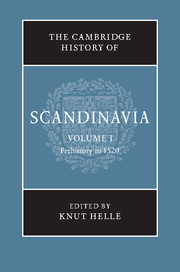Book contents
- Frontmatter
- Introduction
- PART I THE GEOGRAPHY AND PREHISTORY OF SCANDINAVIA
- PART II FROM VIKINGS TO KINGS
- PART III MATERIAL GROWTH (to c. 1350)
- 9 Demographic conditions
- 10 Rural conditions
- 11 Urbanisation
- PART IV THE HIGH MEDIEVAL KINGDOMS
- PART V HIGH AND LATE MEDIEVAL CULTURE
- PART VI LATE MEDIEVAL SOCIETY (c. 1350–1520)
- PART VII SCANDINAVIAN UNIONS (1319–1520)
- Conclusion
- Select bibliography: primary sources, general surveys and secondary works arranged by part
- Index
- Plate Section"
- References
10 - Rural conditions
from PART III - MATERIAL GROWTH (to c. 1350)
Published online by Cambridge University Press: 28 March 2008
- Frontmatter
- Introduction
- PART I THE GEOGRAPHY AND PREHISTORY OF SCANDINAVIA
- PART II FROM VIKINGS TO KINGS
- PART III MATERIAL GROWTH (to c. 1350)
- 9 Demographic conditions
- 10 Rural conditions
- 11 Urbanisation
- PART IV THE HIGH MEDIEVAL KINGDOMS
- PART V HIGH AND LATE MEDIEVAL CULTURE
- PART VI LATE MEDIEVAL SOCIETY (c. 1350–1520)
- PART VII SCANDINAVIAN UNIONS (1319–1520)
- Conclusion
- Select bibliography: primary sources, general surveys and secondary works arranged by part
- Index
- Plate Section"
- References
Summary
Development of settlement
Sedentary settlement in Scandinavia was predominantly agrarian during the Iron Age and the Middle Ages. Grain cultivation and animal husbandry were the basic means of providing sustenance, but were complemented, according to local conditions, by various forms of hunting, fishing and gathering.
We have seen (Chapter 1) that large parts of Scandinavia are marginal for agriculture. In high-lying areas and in the far north climate does not permit grain growing. Areas of high elevation also lack the necessary conditions for pastoralism, which can, on the other hand, be successfully practised in Iceland and also in favourable locations in Greenland.
Nevertheless, the Nordic climate is considerably more favourable than at the same latitudes in many other parts of the globe. This is mainly due to the effects of the Gulf Stream. The positive difference between mean annual temperature in various parts of Sweden and global mean temperature at the same latitudes is between 5 and 7°C.
The distribution of sedentary settlement at the beginning of the Middle Ages, i.e. around AD 1000, can be established in various ways. The archaeological record, mainly cemeteries and dwelling sites, points to the extent and locations of such settlement. With the exception of Finland, types of place-names can be used to determine the age of settlements; for example, certain types of suffixes in place-names belong largely to the Viking Age and earlier periods, others to the Middle Ages and later periods. However, there are also types of names that were widely used during both the Viking and Middle Ages.
Keywords
- Type
- Chapter
- Information
- The Cambridge History of Scandinavia , pp. 250 - 311Publisher: Cambridge University PressPrint publication year: 2003
References
- 6
- Cited by

